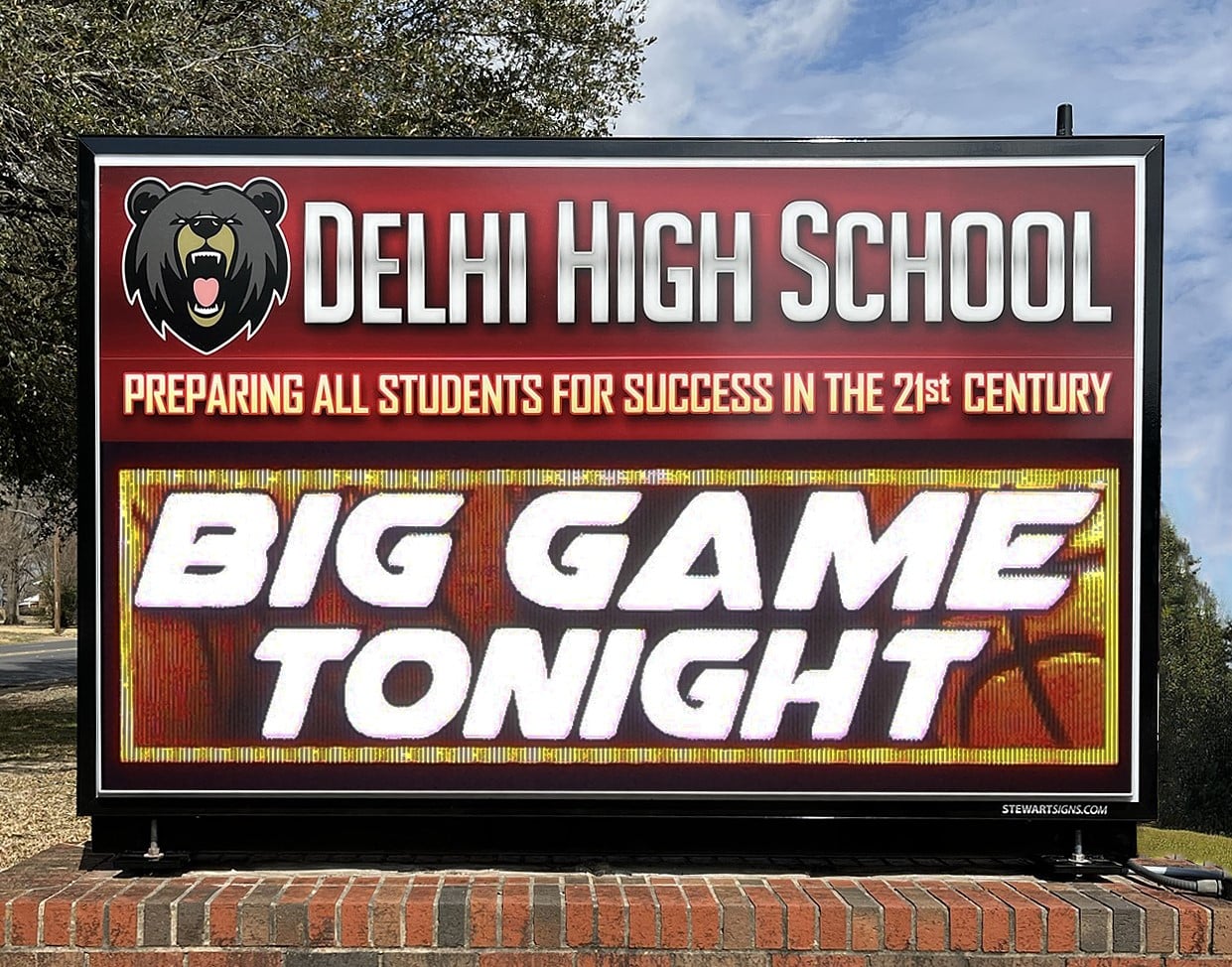Outdoor signs have always been a part of the visual landscape for schools. From the steps of ancient Greek and Roman academies to the exteriors of religious education centers in Medieval Europe and beyond, the need to identify buildings and institutions of their educational purpose has always existed. But these identification markers were missing an important component: a way to communicate timely messages that were both highly visible and easily changed.
In the early 20th century, manual changeable letter signs with their grid of standardized and interchangeable characters were introduced to organizations wanting to communicate more broadly. For many decades, schools relied on these signs to display important information such as event schedules, fundraising activities, and other announcements. These manual signs are still manufactured today and serve their purpose well. They are relatively inexpensive to purchase and maintain, requiring minimal technology and offering a budget-friendly solution for many schools. When placed in strategic locations, these signs can effectively communicate with all who pass by.
However, the process of updating the message on a manual sign is time-consuming and labor-intensive, and their static nature limits them to unchanging text information. Starting in the late 1990s, outdoor display technology reached a price point that allowed schools to begin the transition to electronic signage.
These earliest “electronic message centers” were just that: an upgrade to the manual message center composed of individual letters. With light bulbs or light emitting diodes forming basic text shapes, these messages were changed through specialized terminals, computers or remote control. While this was certainly a relief to the staff members tasked with counting letters, braving the weather, and possibly standing on ladders, it didn’t do much to move the needle of innovation.
As technology has advanced, these simple message centers have transformed into full digital displays. More than just a large TV, these devices must be bright enough for visibility in full sunlight and rugged enough to operate in extreme climates.
An important component of any sign is whether it will be noticed in the constant competition for your audience. These signs are capable of a variety of eye-catching content including video clips, images and animations. This versatility makes them highly engaging and more likely to capture the attention of students, teachers, parents, staff and visitors.
But now that the canvas has been expanded, what content do schools put on these signs? For many, the most important messaging involves localized alerts such as weather-related school closures, lockdown or shelter directives, evacuation routes or other safety instructions. This critical information can be sent immediately to a single sign or a network of signs, ensuring that any emergency messaging is seen and acted upon.
Digital signs can promote upcoming events such as sports games, theater productions, fundraising activities, and parent-teacher meetings. With the ability to display vibrant graphics and video clips, these signs can generate excitement and increase event attendance. Information involving community awareness, volunteer opportunities and partnerships can strengthen the school’s connection with the surrounding area.
However, in speaking with many school sign owners through the years, some of the most powerful content involves celebrating individual student achievements such as academic awards, athletic performance, and artistic accomplishments. Highlighting student success fosters a positive school culture and motivates students to excel. To a young person dealing with issues of confidence and identity, seeing their “name in lights” is a powerful and often transformative experience for them.
Building on this sense of purpose extends to teachers, staff, and the entire school student body. Showcasing both individual and collective success is an important component in creating a sense of school pride. The community itself becomes more aware of the value and service being created right in their backyard, which leads to more opportunity and growth. The ability to show symbols, mascots and other visual brand queues can help to create a cohesive and strong identity for your organization.
One of the most significant advantages of digital signage is the ability to show content based on a scheduled date or time. School zone traffic information, loading and parking guidance, and other safety reminders can be shown during the most relevant hours. Points of contact and other frequently requested information can be provided during scheduled school closures. Special event information can be set with a beginning and end date for optimal message timing.
Many digital signs today offer cloud-based software. Rather than requiring a user to be on campus with installed software on their computer, administrators can control their sign from any location or device and make their updates remotely. Cloud-based systems often come with robust security features, ensuring that only authorized personnel can make changes to the sign message. As schools grow or expand, cloud-based software makes adding new signs to the network easy. This centralized management system ensures that all signs can display consistent messaging.
While the initial investment in digital signage is higher than manual signs, the long-term benefits often outweigh the costs. Digital signs reduce labor costs associated with updating manual signs and can boost both fundraising and event attendance through higher visibility. Some schools partner with local businesses or civic organizations for sponsorship opportunities using the sign itself, providing another source of revenue.
Outdoor signage, whether manual or digital, plays a vital role in the communication strategy of today’s schools. While manual changeable letter signs offer simplicity and reliability, digital signage provides a dynamic and versatile solution that meets the demands of a generation raised with the internet and mobile devices.
As educational institutions continue to adapt to a more interconnected world, embracing digital signage is not just a matter of keeping up with technology; it’s about enhancing communication, improving engagement, and creating a more connected and informed school community.
Wade McKelvey is the director of marketing for Stewart Signs, www.stewartsigns.com. Since 1968, Stewart has provided outdoor signs across the country and specializes in both digital and non-digital signage for the education market.










